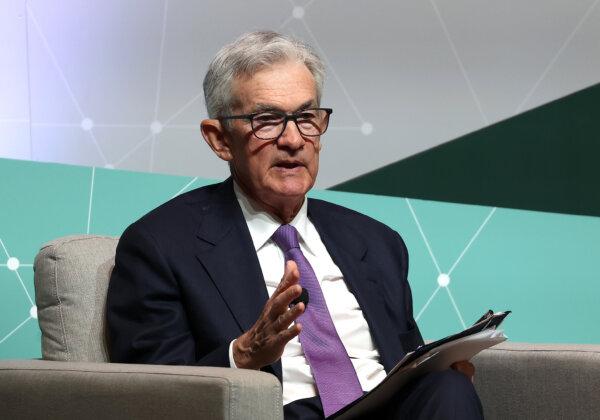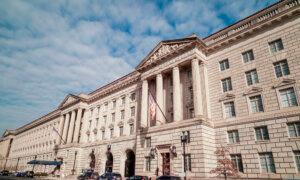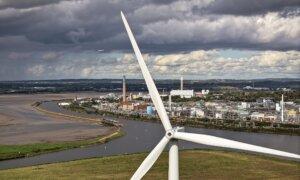The U.S. economy showed signs of slowing in the first quarter as inflation pressures and higher borrowing costs weighed on the country to kick off 2024.
According to the Bureau of Economic Analysis (BEA), the U.S. economy expanded by 1.6 percent in the first three months of the year, down from 3.4 percent in the fourth quarter. The reading fell short of the consensus estimate of 2.5 percent.
The gross domestic product (GDP) is a broad measure of goods and services produced in the United States. The nation has not experienced two consecutive quarters of contracting GDP since the first half of 2022.
Consumer spending eased to 2.5 percent in the first quarter. It contributed to nearly all of the growth in the first quarter.
Government spending slowed to 1.2 percent, with all of it coming from the state and local levels. In fact, federal spending dipped for the first time in two years.
Federal, state, and local spending accounted for 13 percent of the first-quarter expansion.
Price pressures were apparent throughout the GDP data. Personal consumption expenditure (PCE) prices rose to 3.4 percent, up from 1.8 percent. Core PCE, which strips the volatile food and energy components, climbed to 3.7 percent, up from 2 percent. This also topped the market forecast of 3.4 percent.
The GDP Price index, a gauge of changes in prices for goods and services purchased by businesses and consumers, edged up to 3.1 percent, up from 1.7 percent in the October 2023 to December 2023 span. This was slightly above the market forecast of 3 percent.
Net exports of goods and services jumped 0.9 percent, while gross private domestic investment surged 3.2 percent.
The personal savings rate was 3.6 percent, down from 4 percent. Real (inflation-adjusted) disposable personal income advanced 1.1 percent, down from 2 percent.
Market Reaction
The financial markets were in the red before the opening bell, with the leading benchmark indexes tumbling as much as 1.6 percent.U.S. Treasury yields popped following the downbeat GDP data. The benchmark 10-year yield rose to 4.7 percent. The two-year yield eyed 5 percent, while the 30-year bond firmed above 4.8 percent.
Other Economic Data
Financial markets also combed through other economic data on April 25.The goods trade deficit was unchanged at $91.83 billion and came in slightly higher than economists’ expectations of $91.2 billion.
Initial jobless claims fell to 207,000 for the week ending April 20. Continuing jobless claims also slipped to 1.781 million.
Interest Rates and Inflation
But while the quarterly snapshot of the U.S. economy is typically vital news for the financial markets, all eyes will be on the PCE price index.Investors are paying extra attention to the PCE because of its impact on interest rates.
With various inflation metrics trending in the wrong direction, monetary policymakers are making a case for being patient before cutting rates, effectively keeping them higher for longer. As the economy inches closer to the soft-landing scenario, Fed officials assert that they can afford to not urgently pivot on the central bank’s restrictive stance.

Speaking at a panel discussion last week, Fed Chair Jerome Powell conceded that the elevated inflation readings will likely delay rate cuts until later this year.
“If higher inflation does persist,” he said, “we can maintain the current level for as long as needed.”
Although the U.S. economy has weathered a high-rate climate, a number of economists and market watchers warn that the heightened restrictive stance could eventually break something.
The benchmark federal funds rate is currently in the range of 5.25 percent to 5.5 percent. Since monetary policy functions with a lag, the 23-year-high rates are still traveling throughout the economic landscape. Experts are concerned that this could weigh on business and consumer balance sheets, particularly for those with immense debt levels. Banks possessing enormous exposure to commercial real estate and consumer loans could suffer significant losses, resulting in tighter financial conditions.
“Inflation could persist for longer than expected, which could result in more restrictive monetary policy, heightened volatility in financial markets, and corrections in asset prices,” the Fed report reads, noting that foreign economies could also endure considerable strain, particularly emerging markets.
“This stress could transmit to the U.S. through strains in dollar funding markets, rapid rebalancing of portfolios, and reduced credit from foreign lenders to U.S. borrowers.”
In the meantime, economic observers have been surprised by solid growth and labor market trends amid above-trend inflation and sky-high interest rates. Many banks and economists have abandoned their recession calls, forecasting tepid growth prospects as their base case.
The next two-day policymaking Federal Open Market Committee meeting will occur on April 30 and May 1.







